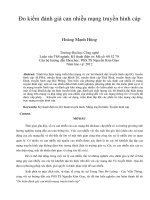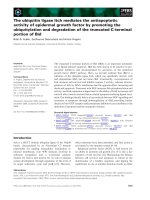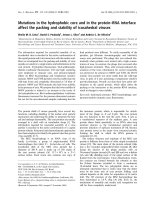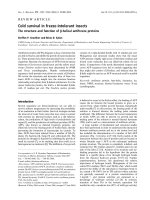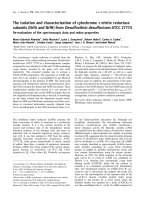the impact and importance of activity based costing on financial performance of manufacturing firm
Bạn đang xem bản rút gọn của tài liệu. Xem và tải ngay bản đầy đủ của tài liệu tại đây (531.66 KB, 73 trang )
1
THE IMPACT AND IMPORTANCE OF ACTIVITY BASED COSTING
ON FINANCIAL PERFORMANCE OF MANUFACTURING FIRM
BY
NGUYEN THANH HOA
Graduation Project Submitted to the Department of Business Studies,
HELP University College, in Partial Fulfillment of the Requirements for
the Degree of Bachelor of Business (Accounting) Hons
JUN 2010
2
DECLARATION OF ORIGINALITY AND WORD COUNT
I hereby declare that the graduation project is based on my original work
except for quotation and citations which have been duly acknowledged. I
also declare that it has not been previously or concurrently submitted for any
other course/degree at Help University College or other institutions. The
word count is 10,663 words.
NGUYEN THANH HOA
Date:
3
ACKNOWLEDGEMENT
This research contains a lot of details and varieties, thus it would be
difficult to carry out it on one‟s own. Receiving encouragement and help
from many people I feel indebted to their aids, and wish to express my
gratitude to them.
First of all, I would like to thank our respected supervisor – Dr. Le
Van Lien for his immense support throughout my research. I would like to
express my indebtedness to Dr. Lien for his continuous guidance and
support during my project. Without his support, my project would not be
completed.
I also reserved on priority of my special acknowledgement to Mr. Tran
Huu Huan - Financial Director of Dutch Lady Vietnam Company, who gave
me useful ideas for my questionnaires.
Thanks also go to many financial managers of Dutch Lady Vietnam,
Mr. Nguyen Trung Kien, Mr. Doan Le Minh, who had continuously guided
me with all the valuable information for my research.
And finally, I am extremely grateful to all the staff of Dutch Lady
Company who cooperated with me during the survey.
4
THE IMPACT AND IMPORTANCE OF ACTIVITY BASED COSTING
ON FINANCIAL PERFORMANCE OF MANUFACTURING FIRM
BY
NGUYEN THANH HOA
Jun 2010
Supervisor: Dr. Le Van Lien
Abstract
The graduation project represents the results of research on impact
and importance of Activity Based Costing (ABC) on financial performance of
manufacturing firm. The contribution of this project is to improve the
financial performance of manufacturing firm by measuring impact and
importance of ABC - a way to measure changes in their productivity of
manufacturing firms. The objectives of the project were to demonstrate
chances in financial performance when manufacturing firms apply ABC
approach. Benefits of applying ABC and factors affecting the successful
performance of ABC approach will provide managers with useful
information in making better decisions on evaluating the application of ABC.
To achieve these above objectives, questionnaires were made and
given to the financial staff of Dutch Lady Vietnam (DLV) Company. They
were required to complete the questionnaires based on their understanding
and perceptions of ABC related to financial performance.
As can be seen, ABC has had a positive influence on improvement of
financial performance at DLV. Thus by applying ABC, managers of
manufacturing firms would be given more accurate information and able to
take the right actions that would improve the profitability and the financial
performance of a company.
5
TABLE OF CONTENTS
Declaration of Originality and word count
Acknowledgement
Abstract
Table of Contents
List of Figures
List of Abbreviations
Chapter 1 INTRODUCTION
1.1 Introduction
1.2 The elements of the research
1.2.1 Research question
1.2.2 Research purpose
1.2.3 Research objective
1.3 Significant of research
1.4 Structure of research
Chapter 2 LITERATURE REVIEW
2.1 Overview
Page
ii
iii
iv
v
x
xi
1
2
2
3
3
4
4
6
6
2.2 Conceptualization of financial performance
2.3 General look at ABC
2.3.1 What is Activity Based Costing?
2.3.2 Fundamental of ABC
2.3.3 Why is ABC needed?
2.4 Implementation of ABC
2.4.1 Cost classification in ABC
2.4.2 ABC in application management cost
2.4.3 Procedure of ABC cost allocation
2.4.4 Comparison with Traditional cost accounting
2.4.5 Benefits of ABC
2.4.6 Limitation of ABC
2.5 Case study from the Literature
2.5.1 Description of DLV
2.5.2 Application of ABC in DLV
2.5.3 Cost management in DLV
2.5.4 Cost allocation in DLV
2.6 ABC with financial performance
6
7
7
8
10
11
11
13
13
13
16
18
19
19
20
23
24
25
7
2.7 Initiative business strategies
2.8 Hypothesis
Chapter 3 METHODOLOGY
3.1 Overview
3.2 Research methodology
3.3 Approach
3.4 Population and sampling procedures
3.5 Data collection
3.6 Questionnaire design
3.7 Reliability
3.8 Data analysis method
Chapter 4 RESULTS OF THE RESEARCH AND ANALYSIS
4.1 Overview
4.2 Discussion of statistic analysis
4.2.1 Respondents
4.2.2 Data analysis method
4.2.3 Reliability and validity
4.2.4 Bias
25
26
29
29
30
31
32
33
35
35
36
36
36
37
37
37
8
4.3 Hypothesis analysis
4.3.1 Does the use of ABC impact financial performance?
4.3.1.1 General discussion
4.3.1.2 Figures
4.3.1.3 Discussion of results
4.3.2 Importance factors impact of ABC and Financial performance
4.3.2.1 General discussion
4.3.2.2 Figures
4.3.2.3 Discussion of results
4.3.2.3.1 Cost
4.3.2.3.2 Information technology
4.3.2.3.3 Business unit complexity
4.3.2.3.4 Intra company transaction
4.3.2.3.5 Competition
4.3.3 Does the benefits of using ABC lead to improve financial
performance?
4.3.3.1 General discussion
4.3.3.2 Figures
4.3.3.3 Discussion of the results
38
38
38
39
40
42
42
42
43
43
44
45
45
46
47
47
47
48
9
Chapter 5 CONCLUSION
5.1 Conclusion
5.2 Limitations
5.3 Recommendations
BIBLIOGRAPHY
APPENDICES
51
52
52
54
59
10
LIST OF FIGURES
Figure
Title
Page
Chapter 2
Figures 2.1
Figures 2.2
Figures 2.3
Chapter 4
Figure 4.1
Activity Based Costing model
Application of ABC in DLV
Diagram of cost management in DLV
The perception of respondents about Activity Based Costing
system
10
22
24
39
Figure 4.2
Component bar charts showing the response of yes
and no for in questionnaire A
40
Figure 4.3
The opinion of respondents about factors that affect of Activity
Based Costing system on Financial Performance
42
Figure 4.4
Component bar charts showing the response of yes
and no for in questionnaire B
43
Figure 4.5
The reaction of respondent about benefits of firm when
applying Activity Based Costing method
47
Figure 4.6
Component bar charts showing the response of yes
and no for in questionnaire C
48
11
LIST OF ABBREVIATIONS
Abbreviation
Full Name
ABC
Activity Based Costing
DLV
Dutch Lady Vietnam
IT
JIT
TCA
Information Technology
Just - in - time
Traditional Cost Accounting
TQM
Total Quality Management
12
Chapter 1
INTRODUCTION
1.1 Introduction
In the 1990s business strategy played an essential part in financial
operation. With the expansion of productivity, and the complexity of
business management, efficient financial performance has become a very
common term. Researches have shown that cost accounting has been one of
the most vital parts of managerial accounting. It is used to control a
company‟s cost and provide management with accurate information on
financial operation and performance. At that time Traditional Costing system
trace overhead costs to the product based on the assumption that product
cause costs. It takes a total cost and assigns it to each part of the process. It is
the fact, it relies on an essentially illogical allocation of indirect costs, and
thus systems do not give managers accurate product cost information, which
leads to inaccurate calculation of product profitability. Therefore Traditional
Cost Accounting (TCA) has not reflected the realities of financial
performance of manufacturing firm and can mislead and increase production
costs and have major negative effects on a company‟s profits.
Introduced by Robin Cooper and Robert S. Kaplan (1991) Activity
Based Costing (ABC) was described as a potential approach to solve
traditional costing problems. It soon claimed its major advantages and
overcame limitations of TCA despite of a rising number of questions
13
concerned with adoption and implementation ABC. However Ittner ET all
(2002) stated that ABC would only have indirect effect on financial efficiency.
Since then various studies have been conducted on the real benefits and the
actual influences of ABC on performance of accounting system and
production of a company in order to see whether or not applying ABC was
the right solution. This project will illustrate the impact and importance of
ABC on financial performance of manufacturing firms. In addition, it will
focus on the empirical testing of the impact of ABC in Dutch Lady Vietnam
(DLV) and the effect of ABC to financial performance.
DLV Company is a subsidiary of Friesland Foods – a firm operating
based on profits. All business activities in DLV are aimed to increase
additional values to investors. Its business activities are supposed to gain a
profit that can cover its capital cost. This project is based on certain
perceptions and experiences on implementing this method in this firm in
order to verify these following hypotheses.
1.2 The elements of the research
1.2.1 Research question
Can the application of ABC on manufacturing firm lead to impact on
financial performance?
14
1.2.2 Research purpose
The purpose of this research is to provide managers with relevant
information, for them to be able to make better decisions regarding the usage
of ABC on their firms.
1.2.3 Research objective
The objective of this project is to demonstrate hypotheses arising from
the use of ABC and how it would play a very significant part in financial
performances and the relationships between them. Various researches about
ABC have been conducted but none of these studies indicated identical view
toward the use ABC. It is shown that financial performance of a firm
applying ABC could be different from those who use TCA. Certain factors
affecting ABC were also analyzed. Therefore, hypotheses were conducted to
study ABC‟s impact and in order to understand ABC and its role in financial
performance.
Hypotheses on ABC will be also analyzed by studying manufacturing
firms which have been applying ABC for several years. Quantitative research
was used to obtain information which focuses on numerical data, financial
reports; survey was given to auditors and financial executives of a company
to gather information on ABC and its relation to financial performance. This
was carried out by discussing the research questions, questionnaire design,
the data collection, population and sampling, variables, data analysis and
reliability.
15
After the statistical analysis was conducted, based on the data
gathered, results will reveal the positive effect of ABC and will demonstrate
the strong connection between ABC and efficient financial performance.
1.3 Significance of research
This project will verify the benefits of ABC which provides accurate
information and precise costs and updates daily for financial managers in
decision-making, production controls and business operations. Moreover,
this project also contributes to other previous researches by studying the
impact of using ABC not in general manner but in depth of how ABC
influences a firm‟s accounting process. Being aware of applying ABC
successfully, managers can improve their business operations, thereby
improving the quality and management activities, increasing
competitiveness and economic power in open market economy; and as a
result this may also have a great effect on the success of a company. In
addition, this project will demonstrate the current limitations of ABC which
may enable future researches to make improvements to this model.
1.4 Structure of research
The project is organized as follow:
Chapter 1 introduces the problem of research. It identifies the research
question, the purpose, the objective and the significance of the project; a
structure of the project is also included in this chapter.
16
Chapter 2 gives a review of the relevant literature. Specifically it gives
information about the principles of ABC and the financial performance.
Chapter 2 also includes the application of ABC in DLV; and covers the three
hypotheses which indicate the impact and importance of ABC on financial
performance.
Chapter 3 presents the research methods, techniques as well as data
collections. This chapter creates the perception of the staff regarding to the
use of ABC in DLV.
Chapter 4 presents the three results of the hypotheses which were
discussed in chapter 2. All of the cases are based on the company‟s staffs. The
first hypothesis shows the impact of ABC on financial performance; the
second hypothesis demonstrates some factors affect of using ABC on
financial performance of the company. Finally, the third hypothesis
illustrates that using ABC leads to the improvement of financial
performance.
Chapter 5 includes the conclusions derived from this research and the
contribution of this research to existing body of knowledge. It also discusses
about limitations of current ABC model and future research opportunities.
17
CHAPTER 2
LITERATURE REVIEW
2.1 Overview
This chapter consists of main sections such as general aspects of the
impact and importance of ABC method on Financial Performance of
manufacturing firm; the applying of ABC in DLV Company and the
hypotheses.
2.2 Conceptualization of financial performance
Financial performance is the measuring of the results of a firm‟s
policies and operations in monetary terms. In the manufacturing firms,
financial performance refers to the rate of return for a financial portfolio. The
portfolio includes the financial instrument which is used with different level
of risk of different rate of return (Cagwin and Bounman, 2002).
In current business environment, financial performance has related to
the profit of firm. Sales profit and cost was used to evaluate the value of
business activities. These values will be measured with current budgets or
sales forecast to create business strategy in which to answer the “big
question “: how to maximize sales profit, reduce cost and better financial
management.
18
2.3 General look at ABC
2.3.1 What is Activity Based Costing?
Traditionally, the cost of manufacturing a product have categorized as
direct material, direct labor and overhead. Traditional cost systems trace
overhead costs to the product based on the assumption that products cause
costs. (Turney, 1990).
On the other hand, ABC focuses on activities in manufacturing the
product. ABC is defined by Computer Aided Manufacturing - International
(CAM-I) as “Activity Based Costing integrates financial and non – financial
related to activities performed in a firm to produce goods and services”. In
this instance, costs assigned to products are based on resource consumption
of activities to produce goods.
As defined in MBA venture line Business Dictionary: “Activity Based
Costing is a costing system that identifies the various activities performed in
a firm and use multiple cost drivers (non volume as well as volume based
cost drivers) to assign overhead costs (or indirect costs) to product. ABC
recognizes the casual relationships of cost drivers with activities”.
According to Deepak Mohan & Hemantkumar Patil (2003), “Activity
Based Costing is a costing model which to measure activity costs, results,
resources and cost objects. ABC assigns resources to activities, activities to
cost objects according to actual consumption by each and recognizes the
19
causal relationship of cost drivers with activities, ABC focuses more on costs
and the cause based on process and activities rather than on departments
and traditional functions”.
From the view of Stewart, G.B (1991), “Activity Based Costing
provides complete data on business activities in “financial metric form” It
can be applied to business according to variable factors – thus it is more
innovative compared with TCA, ABC has three main objectives: A tool to
guide strategic decision making; insights in process of business to allowed
resources to be efficiently allocated and minimize costs; an allocation
technique in determining internal cost prices and selling prices”
Therefore, ABC can be defined as a model of aggregated financial and
non financial data related to operation activities in a firm to produce goods,
by assigning resource consumption in a firm to products and services
provided to customers.
2.3.2 Fundamental of ABC
ABC is based on ideas: product design, productivity and distribution
require diverse activities to be performed; the performance of the activities
demands for the purchase and use resources, these generate costs (Cooper
Robin, 1988).
ABC includes that: resources lead to costs, activities consume
resources and products consume activities (Novin, Adel M, 1992). Thus, a
firm‟s activities are identified, then costs are assigned to those activities or
20
activities cost pools based on resources required. After that costs are
allocated and traced from activity cost pools to products based on
proportional use of each activity. In this theory, ABC is aimed at refining
limitation of TCA or Inventory costing method.
Activities are works, actions, or specific tasks performed in a firm
(Novin, Adel M, 1992). For example, the transportation of raw materials from
Warehouse to factory is the activity. Activities selected in establishing ABC
system are main operating activities and often performed by a variety of
supporting activities. For example, many different activities performed in
purchasing such as order preparation, negotiating with suppliers, these
activities will be organized within ABC system.
Cost drivers are the qualitative measures of consumed resources to
produce an activity, used to allocate cost of a consumed resource connected
to one or more activities (Novin, Adel M, 1992).
Activity drivers are the quantitative measures of the number of
activity units performed with a cost pool object, used to allocate activity costs
to output (Novin, Adel M, 1992). For example, the number of operating
machine hours to produce Dutch Lady sweetened milk at DLV.
Cost drivers and activity drivers are the same in nature. Each factor is
the basic cause of costs. In general, anything that producer‟s activities causes‟
activity costs. These factors are related to changes in costs, measuring and
determining cost volume.
21
The connection between activities and cost objects are implemented by cost
driver activity, this is core of improvements in ABC model.
Figure 2.1 Activity based costing model
2.3.3 Why is ABC needed?
ABC is a costing system which is applied in many manufacturing
firms. Many researchers noticed ABC method and considered ABC as an
innovation in cost management accounting. Many ideas stated that ABC
method is necessary to trace overhead costs to cost objects and thus properly
account for batch and product- level costs (Cooper 1990). Moreover, Robin
Cooper, Robert Kaplan and H.Thomas Johnson reported that ABC method is
a costing method employed to assign direct costs to the general audience
costs (Cooper, 1998a; 1998b; 1990; Cooper and Kaplan, 1998; Johnson 1990).
Thus, ABC method is designed to devise the limitations of TCA. ABC also
enables managers to make right decisions, corresponding with product
structure and competitive strategy of a company. Although ABC system is
Costs
Resources
Costs
Activity
Cost Object
22
applied widely in manufacturing firms, according to Rotch (1990); according
to Tanju and Helmi (1991), Activity Based Costing can be used in all forms of
business firm. Many writers recommend using ABC method to support
improvement in Work - in - process (Turney 199Ib) and develop designs of
product cost efficiently (Cooper and Turney, 1990).
2.4 Implementation of ABC
2.4.1 Cost classification in ABC
- Activity levels
To determine costs of resources to activity, according to Blocher
(1991), a business must classify levels of costs, resources and activities. ABC
system often uses a four-level system:
+ Output unit level costs
Output unit level costs are costs of activities performed on each
individual unit of products and services which are assigned directly to
products (Blocher, 1991). For example, production costs to turn raw materials
into units of product. These activities must be performed on each unit such
as direct labor costs that are related to activities of running automated
machinery.
23
+ Batch Level costs
Batch level costs of activities are related to a group of products and
services, which help to produce a batch of product rather than each
individual unit of products (Blocher, 1991). A good example is production
planning for a batch of product or service, when a business purchases a
variety of raw materials, purchasing costs account for a considerable
proportion in overhead. Purchasing cost involves costs of order planning,
raw material receiving, and payment to suppliers.
+ Product Sustaining Costs
Product sustaining costs are costs of activities undertaken to support
individual products or services regardless of the number of units or batches
in which units are produced and consumed, such as product design,
marketing, advertising, research, etc (Blocher, 1991).
+ Facility Sustaining Costs
Facility sustaining costs are costs of activities performed at each
facility that can be seen as periodical costs (Blocher, 1991). They are traced to
all activities performed at every stage to support the organization as a whole,
such as management costs, facility sustaining cost, taxes and asset assurance.
Most activities of facility sustaining costs are assigned to all products and
cannot be traced to each individual product because they support the
business as a whole.
24
2.4.2 ABC in application management cost
ABC is one of the best ways to improve costing. ABC system improves
costs by focusing on individual activities as the basis of cost objects. An
activity is an event, task or a job with a goal defined. For example products
design, operating machinery, product distribution. ABC calculates individual
activities and allocates these costs to the object. Since direct costs can be
charged to each product, ABC can focus on indirect costs, improve cost
allocation to departments, processes and products.
2.4.3 Procedure of ABC cost allocation
According to Cooper (1998c), procedure of ABC cost allocation has
two steps:
Step1: All cost originated during a given period are gathered and
assigned to each activity based on appropriate cost consumption.
Step2: Base on performance of each activity in production and sales to
assign activity costs to product‟s price.
2.4.4 A comparison between ABC and TCA
Similarities
Compton, Ted R. (1996) stated that costs in TCA are allocated to
products mainly based on direct or indirect cost classification. Raw material
costs are considered as those that are assigned directly to products. Direct
labor costs are seen as costs directly connected to product and are based on
25
number of working hour. Overhead costs are the biggest concern and are
assigned to products based on number of working hours and hours of
running machines.
Activity Based Costing also gathers cost factors into cost pool and uses
suitable cost driver to assign costs to product.
Differences
Cost centre / Activity centre
In Traditional Cost Accounting, costs are gathered into cost centres
because this centres are established based on function or purposes, it is
convenient in collecting costs originated in the centers.
In ABC, activities of a company are objects to analyze; costs are
computed based on these activities. Then an organization can decide
appropriate activities for their business operation. Coskins, G, (1997) said
that there are activities in a business which are not connected to product such
as: training, sales representatives, cost of these indirect activities are assigned
to main activities which are closely related to products.
Cost driver
In TCA, costs are allocated based on the number of working hours on
hours of running machines. However, in many cases this allocation base is
not persuasive, not related to the use of resources, which makes costs wrong,
unreliable.


